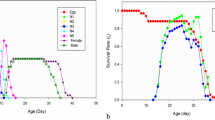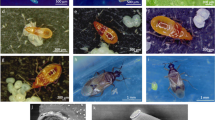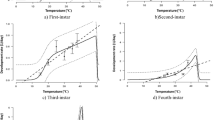Abstract
Dortus primarius Distant (Hemiptera: Miridae) is a predatory mirid bug and found to feed on soft bodied insects in the field. Rearing protocol has been developed for this predatory bug. Abiotic factors like temperature influences the development, survival, fitness, population dynamics and reproduction of insects. The objective of this study was to determine biological and life table parameters of D. primarius at five temperatures (15 °C; 20 °C; 25 °C; 30 °C and 35 °C) with relative humidity of 60 ± 5% and photoperiod of 12 h. Maximum hatching (93.86 and 76%) and nymphal survival (83.28 and 71.66%) was observed at 25 and 30 °C, respectively. Total developmental period was higher at lower temperatures (15 and 20 °C). The Kaplan–Meier’s survival curves showed significant differences in male and in female according to the temperature and an increase in temperature resulted in a decrease in survival time. Life table parameters exhibited higher net reproductive rate (R0), precise intrinsic rate of increase (rm), finite rate of increase (λ) and hypothetical F2 females at 25 °C which makes it ideal temperature for rearing. The data generated through studies on biology and fertility will ensure continuous availability of a laboratory culture of this bug which can be used against different insect pests.


Similar content being viewed by others
Availability of data and material
The datasets used and/or analysed during the current study are available from the corresponding author on reasonable request.
Abbreviations
- lx :
-
Age specific survival
- mx :
-
Age specific fecundity
- R0 :
-
Net reproductive rate
- Tc :
-
Approximate duration of a generation
- rc :
-
Approximate intrinsic rate of increase
- rm :
-
Precise intrinsic rate of increase
- T:
-
Net generation time
- λ:
-
Finite rate of increase
- rw :
-
Weekly multiplication of the population
- DT:
-
Doubling Time
- WMR:
-
Weekly multiplication rate
References
Barbosa LR, Santos F, Soliman EP, Rodrigues AP, Wilcken CF, Campos JM, Zanuncio AJV, Zanuncio JC (2019) Biological parameters, life table and thermal requirements of Thaumastocoris peregrines (Heteroptera: Thaumastocoridae) at different temperatures. Sci Rep 9:10174. https://doi.org/10.1038/s41598-019-45663-5
Birch LC (1948) The intrinsic rate of natural increase of an insect population. J Anim Ecol 17:15–26
Chen Q, Li N, Wang X, Ma L, Huang J-B, Huang G-H (2017) Age-stage, two-sex life table of Parapoynx crisonalis (Lepidoptera: Pyralidae) at different temperatures. PLoS One 12(3):e0173380. https://doi.org/10.1371/journal.pone.0173380
Constant B, Grenier S, Bonnot G (1996) Artificial substrate for egg laying and embryonic development by the predatory bug Macrolophus caliginosus (Heteroptera: Miridae). Biol Control 7:140–147
Ebrahimi M, Mahdian K, De Clercq P (2019) Life-history parameters and predation capacity of Macrolophus pygmaeus and Nesidiocoris tenuis (Hemiptera: Miridae) on eggs of Plutella xylostella (Lepidoptera: Plutellidae). Agr Forest Entomol 21:50–57. https://doi.org/10.1111/afe.12302
Fauvel G, Malausa J, Kaspar B (1987) Etude en laboratoire des principales characteristiques biologiques de Macrolophus caliginosus (Heteroptera: Miridae). Entomophaga 32:529–543
Hansen DL, Brødsgaard HF, Enkegaard A (1999) Life table characteristics of Macrolophus caliginosus preying upon Tetranychus urticae. Entomol Exp Appl 93:269–275
Jones WA, Snodgrass GL (1998) Development and fecundity of Deraeocoris nebulosus (Heteroptera: Miridae) on Bemisia argentifolii (Homoptera: Aleyrodidae). Fla Entomol 81:345–350
Kapadia MN, Puri SN (1991) Biology and comparative predation efficacy of three heteropteran species recorded as predators of Bemisia tabaci in Maharashtra. Entomophaga 36:555–559
Keil G, Cummings E, de Magalhães JP (2015) Being cool: how body temperature influences ageing and longevity. Biogerontology 16:383–397
Lamine K, Lambin M, Alauzet C (2005) Effect of Starvation on the Searching Path of the Predatory Bug Deraeocoris lutescens. Biocontrol 50(5):717–727
Martínez-García H, Román-Fernández LR, Saénz-Romo MG, Pérez-Moreno I, Marco-Mancebón V (2016) Optimizing Nesidiocoris tenuis (Hemiptera: Miridae) as a biological control agent: mathematical models for predicting its development as a function of temperature. Bull Entomol Res 106:215–224
Martínez-García H, Saénz-Romo MG, Aragón-Sánchez M, Román-Fernández LR, Sáenz-de-Cabezón E, Marco-Mancebón V, Pérez-Moreno I (2017) Temperature-dependent development of Macrolophus pygmaeus and its applicability to biological control. Biocontrol 62:481–493. https://doi.org/10.1007/s10526-017-9798-8
Molla O, Biondi A, Alonso-Valiente M, Urbaneja A (2014) A comparative life history study of two mirid bugs preying on Tuta absoluta and Ephestia kuehniella eggs on tomato crops: implications for biological control. Biocontrol 59:175–183
Perdikis DC, Lykouressis DP (2002) Life table and biological characteristics of Macrolophus pygmaeus when feeding on Myzus persicae and Trialeurodes vaporariorum. Entomol Exp Appl 102:261–272
Riudavets J, Castañé C (1998) Identification and evaluation of native predators of Frankliniella occidentalis (Thysanoptera: Thripidae) in the Mediterranean. Environ Entomol 27:86–93
Sagarra LA, Vincent C, Peters NF, Stewart RK (2000) Effect of host density, temperature, and photoperiod on the fitness of Anagyrus kamali, a parasitoid of the hibiscus mealybug Maconellicoccus hirsutus. Entomol Exp Appl 96:141–147
Sanchez JA, Lacasa A, Arno J, Castane C, Alomar O (2009) Life history parameters for Nesidiocoris tenuis (Reuter) (Heteroptera: Miridae) under different temperature regimes. J Appl Entomol 133:125–132. https://doi.org/10.1111/j.1439-0418.2008.01342.x
Sayyed AH, Saeed S, Noor-Ul-Ane M, Crickmore N (2008) Genetic, biochemical, and physiological characterization of spinosad resistance in Plutella xylostella (Lepidoptera: Plutellidae). J Econ Entomol 101(5):1658–1666. https://doi.org/10.1093/jee/101.5.1658
SPSS Inc. Released (2009) PASW statistics for windows, version 18.0. SPSS Inc., Chicago
Susman I (1988) The cotton insects of Israel and aspects of the biology of Deraeocoris pallens Reuter (Heteroptera, Miridae), predators of the tobacco whitefly Bemisia tabaci in Israel. M.S. Thesis, Tel Aviv University, 154 pp. (In Hebrew with English summary)
Thomson LJ, Macfadyen S, Hoffmann AA (2010) Predicting the effects of climate change on natural enemies of agricultural pests. Biol Control 52:296–306
Varley GC, Gradwell GR (1970) Recent advances in insect population dynamics. Annu Rev Entomol 15(1):1–24. https://doi.org/10.1146/annurev.en.15.010170.000245
Varshney R, Yeshwanth HM, Ballal CR (2018) Biology and rearing protocol for Dortus primarius Distant, a predatory mirid (Hemiptera: Miridae). J Biol Control 32(4):224–229. https://doi.org/10.18311/jbc/2018/22438
Wheeler AG, Stinner BR Jr, Henry TJ (1975) Biology and nymphal stages of Deraeocoris nebulosus (Hemiptera: Miridae), a predator of arthropod pests on ornamentals. Ann Entomol Soc Am 68:1063–1068
Wheeler AG (2001) Biology of the Plant Bugs (Hemiptera: Miridae): Pests, Predators, Opportunists. Cornell University Press, New York
Acknowledgements
The authors are grateful to Indian Council of Agricultural Research, New Delhi, India and Director, ICAR−NBAIR Bengaluru, India for providing research facilities and encouragement. We are also thankful to Mrs. Usha Ravikumar for technical assistance.
Author information
Authors and Affiliations
Contributions
RV conceived the study. RV performed experiments and analyzed the data. NB made survival curve. RV wrote the manuscript. Both the authors have read and approved the manuscript.
Corresponding author
Ethics declarations
Ethics approval/ consent to participate
This manuscript does not contain any studies with human participants or animals performed by any of the authors.
Consent for publication
NA
Conflicts of interest
The authors have not found any potential conflicts of interest, and all ethical aspects are considered.
Additional information
Publisher's Note
Springer Nature remains neutral with regard to jurisdictional claims in published maps and institutional affiliations.
Rights and permissions
About this article
Cite this article
Varshney, R., Budhlakoti, N. Development and fertility parameters of a predatory bug, Dortus primarius Distant (Miridae: Deraeocorinae) at different temperatures. Int J Trop Insect Sci 42, 1769–1775 (2022). https://doi.org/10.1007/s42690-021-00703-4
Received:
Accepted:
Published:
Issue Date:
DOI: https://doi.org/10.1007/s42690-021-00703-4




